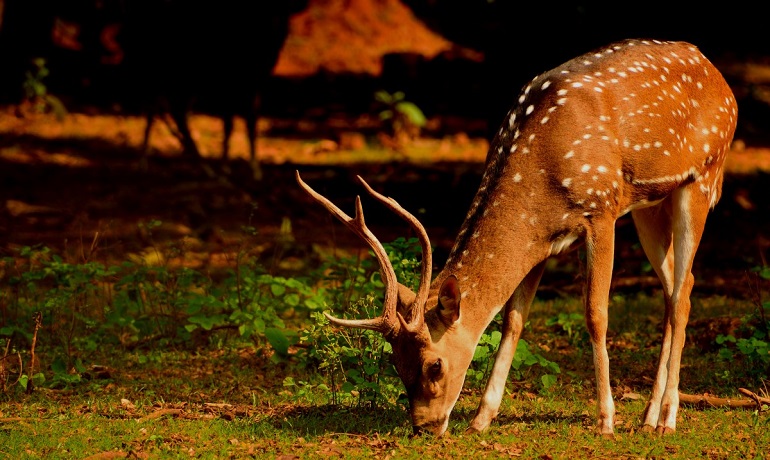A deer is known for its gentle nature and pretty docile demeanor. It’s a pleasant animal, that’s quite endearing to look at.
Just like all other animals, it also has different species, and a rich history is associated with it.
In this article, we will walk you through everything related to a deer, from its morphology to its behavior and from its diet to its taxonomy.
Etymology and Terminology

The word deer originated from the Middle English term dere, deere, or deor, which means a small animal; and from the Old English word, dēor, meaning an animal. It also cognates with Scots dere meaning deer, and the Swedish djue meaning animal.
The old English deor, is used for beast or wild animal, and in Middle English, it’s used for fish. It also gets its origin from the Germanic word referring to animals. Mostly it’s restricted to the Dutch dier and German tior meaning animal.
The terminologies connected to deer are not too expansive. Even a person getting to know about this animal for the first time would be well aware of most of them. Where the male deer is called a buck, the female deer is known as a doe.
Deer are also sometimes named on the basis of their color and gender. For instance, the stag is a red deer that’s male. A deer of the female gender that’s older than three years is called a hind. A Fawn is an adorable, young deer.
The scientific name of all deer species is Cervidae.
Morphology and Behavior

Deer is quite a renowned animal all across the globe. In the hostile world, it showcases the aura of gentleness and benignity. Though it’s considered to be a noble animal in the animal kingdom, its agility and swiftness are its biggest strengths.
Alongside this, deer, especially the young fawns, are able to digest vegetation of almost all kinds and forms. Its evolutionary tale is definitely a success, which showcases development and progress.
The total number of species of deer is not yet agreed upon by the taxonomists. However, most studies come to the conclusion that there are as many as forty to fifty species of deer living on the face of the Earth at the moment.
Where the White-Tailed Deer family is the most widely spread species of deer across the globe, you would see the red deer living in north Africa, Europe, and Asia. North America has an enormous number of Mule deer residing there, while reindeer, also known as Caribou, is found in the arctic region.
The biggest part of the deer family is the Moose. However, they are not much friendly! Compared to other species, they have a tendency to become aggressive and showcase annoyance when they come in contact with humans.
In general, deer are gentle, docile, and quiet. This is why they can easily be a part of the human social set-up. If they do, you would see them quietly eating in your backyard or sleeping there, crossing the roads and being a part of your life gently. Most species prefer making herds and have a social setup of their own.

At the same time, a lot of deer species like living in a solitary manner. This behavior is also dependent upon the sex, age, and species of the deer. Those who like solitude are territorial and mostly male in gender.
Being a shy animal, a deer is mostly unnoticeable to humans, even if they are existing in huge numbers around the locality. However, whenever there is a possible danger, they tend to be super-efficient in responding to it.
They don’t only possess the ability to run away from it with great speed but can also cover themselves up under massive shrubs. A lot of times, a deer tends to respond to possible danger by being nocturnal. It starts to avoid coming to a busy place and showcases anti-social behavior.
A deer is graceful, friendly, and elegant in its conduct. However, at the same time, they symbolize strength and robustness as well. Not being inherently aggressive, they don’t attack humans as such. Most of the time, they tend to run away when they come in contact with humans or other larger animals.
While maneuvering around, they prefer grazing and consuming short plants, rather than finding prey. Shrubs and nuts are also a prominent part of their diet.
Despite being docile, the male deer have been reported to showcase aggressive behavior towards each other. Studies relate this behavior more prevalent within a herd. This could be a result of competition for space and food. The showcase of aggression is in the form of kicking and barging.
The red dear and sika deer tend to live in segregated herds. It’s only during the mating season when the male and female animals get together. Being sensitive to the colder weather, the deer tends to stay in cover and avoid coming out too often. Deer browsing in the sheltered parts of woodlands is also a common behavior during winter.
This animal is super protective of the younger bucks. While looking for food, they tend to cover and hide their younger ones. The big body size tends to help the younger conceal themselves behind adult bucks.
Historic Background

The history of deer dates back around three million years back. They evolved through the Pleistocene period. These large mammals showcase an evolution from being small animals with canine tusks.
Evolved from the antlerless, the ancestors of deer had an uncanny resemblance with the duikers of the modern day. With time, they developed into cervids in Miocene, but have now gone extinct.
The deer descended from the Asiatic animal is the one that’s now residing in North America. It has moved all the way from Miocene to the Pleistocene epochs. This makes it history as old as eighteen million years!
These hoofed ruminant mammals are now widespread across the globe, and if you reside somewhere in the United States of America, you would be able to spot them quite easily. Now, the white-tailed deer is a part of the big game of New York.
Indigenous to Western North America, the mule deer have been around for as many as 10,000 years. They evolved in North America, hence have a shorter history than other deer species.
Lifespan

It would amaze you that the lifespan of the deer residing in the wild is much lesser than that of those living in captivity. Owing to its widespread hunting, both by humans and wild animals, they tend to lose their life quite early and have an average life of three to six years.
Comparatively, those who live in captivity live up to seven to nine years. As they are safe from all kinds of hunting, they get to live longer.
Alongside this, it has also been observed that females can give birth even quite late in their lives as well. Hence, those living in captivity are able to showcase a high level of reproductive abilities.
Mule Deer and a Short Lifespan
One major specie that gets affected by being close to the native habitat is the mule dear. With more people living there, the hiding spaces get limited with time. Hence, they can’t run away from danger and get their lives saved from a predator.
The Lifespan of the White-tailed Deer
The white-tailed deer lives from three to five years, while its female counterpart lives around two years more than that! This also fluctuates according to the location of the deer. If it resides somewhere that’s easily accessible by the hunters, be those animals or humans, its life would be consistently at risk.
Areas prone to natural disasters also affect the life expectancy of the deer.
Diet
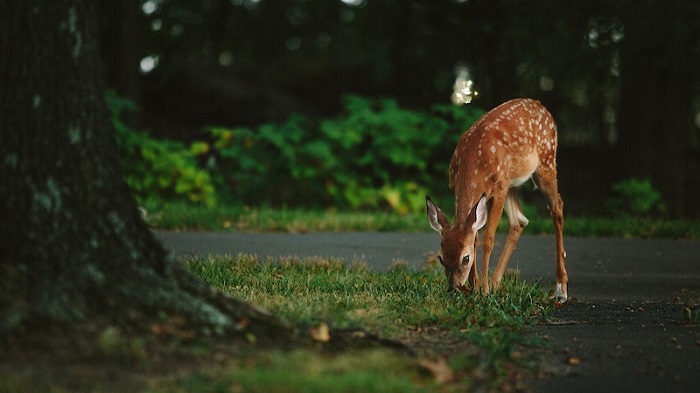
Deer are quintessentially herbivores, which means that they love eating greens! When they maneuver around, they keep observing the surroundings and devour leaves, grass, stems, nuts, and even woody plants. Hence, one can say that these hoofed mammals are lovers of everything natural and green.
Being ruminants, animals with an advanced digestive system, deer can easily digest fibrous food.
The enzymes produced by the salivary glands work efficiently when it comes to deactivating the secondary compounds of the plants, which tend to affect digestion negatively. By doing so, it gets easier for them to devour a wide variety of plants, even the most complex ones!
A lot of scientists have also reported that a wild deer loves consuming berries, shoots, and even twigs. Also, as these items are easily available and accessible in their habitat, it’s possible for them to maintain a healthy diet throughout their lifetime.
Those residing in dense forests obviously have no shortage of food whatsoever! They also get really high-quality food available for them at all times.
Change of Eating Pattern
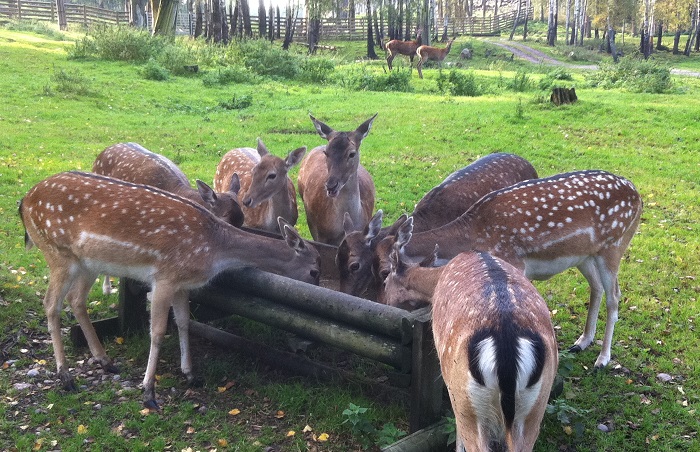
As a matter of fact, the diet of a deer also depends on the season and the place of living. With the change of the season, there is a slight change in what they may eat.
For instance, they may shift from the browse to the forbs, which is moving from the leaves of the woody plants to the agricultural crops, as the season changes.
A high-quality food for the deer is one that offers maximum nutritional value. Forbs and browse surely fall into the category of high-quality food items as they fulfill as much as eighty percent of the nutritional needs of all deer populations, including that of the older bucks.
Though the deer herbivores feed majorly on plants, occasionally they eat fruit and berries as well.
Despite the fact that this animal is unproblematic in terms of its eating habits, it causes some issues for the woodland ecosystem. As it ends up consuming young trees, the natural growth of the expansive woodland gets hindered. This impact is then checked by the natural predators of deer, including lynx and wolves.
Feeding deer may also come in conflict with the interests of humans. A lot of times, in the urge to consume some greens, they end up destroying the well-grown lawns and gardens of humans. This destruction of the crops is pretty massive at times when a herd of deer decides to feed on it.
Reproduction and Offsprings
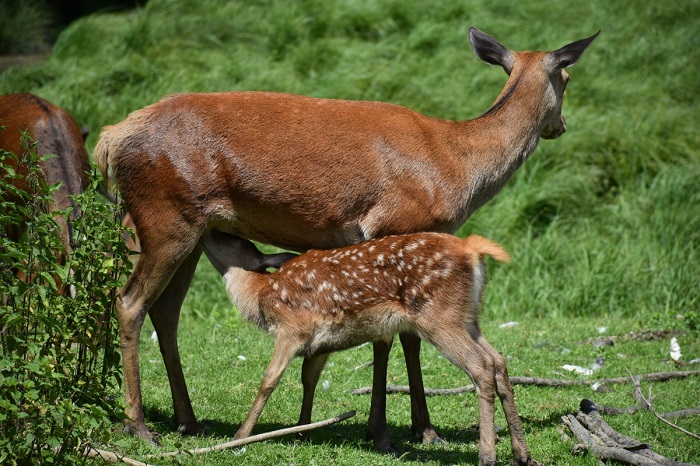
The reproductive patterns showcased by different deer species are distinct from each other. As seasonal breeders, they showcase the rutting behavior mainly during the start of the fall season. The change of season makes different species showcase different behaviors.
During the short days when lighting is for a limited period, deer respond the best and showcase rut behavior. The highest estrous behavior is showcased from September to October.
Get to Know about the Breeding Behaviour
The breeding behavior of the deer is called RUT. It mostly peaks during October. The melatonin levels of these animals control the rut and breeding behavior.
When the daylight is low, the testosterone of a buck is triggered, leading to the antler getting mature. Just like males, females are also short-day breeders, turning into estrus mainly during October.
Though the breeding happens around the year, different species choose their own mating season in terms of timing.

During this mating season, they tend to move out of their locality, which also makes them more prone to accidents with humans as well. This is also the time when even the deer-vehicle collisions are the highest!
In terms of reproductive organs, males possess antlers. They use them to battle for the females during the peak rut season. In the deer family, it’s only the reindeer whose females also grow antlers. When the female adult deer grow antlers, they use them to clear off the snow and defend themselves.
Hence, it’s a reported fact that the peak breeding season for adult deer is from October to December. This mating season brings the wild animals closer, leading to the birth of a baby deer. The mating trend amongst the deer makes a male prefer a native deer of the opposite gender to create offspring.
As soon as the female gives birth to the fawns, she takes them to a secluded place to nurse them. The young offspring are called fawns, which are mostly born during the spring season.
The red deer offspring stays in the dam for around one year. After that, the males become a part of the herd. On the other hand, amongst the Roe and Muntjac species, the fawn stays in the dam till the birth of the next offspring.
Importance of Deer in the Ecosystem
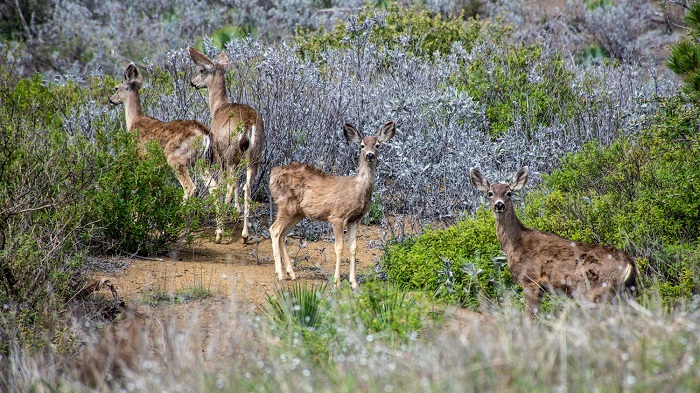
You would be amazed to know that the deer seems quite benign, but is extremely important in the ecosystem. While keeping the population of certain producers checked, they make sure to disperse seeds and may even end up becoming prey for secondary consumers.
As they feed on greens, they aid nature in the process of weathering and erosion. The plant density is checked by the deer that grazes. They aid in modifying the pattern of abundance and ensure dynamic vegetation within their habitat.
Alongside this, they help in the dispersal of plants across space. While grazing, they disperse the seeds and deposit them at farther sites through feces. This way, they ensure a wide spread of the greens.
Deer as a Source of Food
Being a major source of food for the consumption of secondary and tertiary animals, they help in their survival in the ecosystem as well. Mostly, they get eaten up by coyotes and wolves.
At the same time, it’s important to know that with the deer population becoming over-abundant, over-browsing may happen. It could lead to reducing the plant diversity, leading to the removal of shrubs and small plants owing to the expansive browsing of this animal.
Old and New World Deer
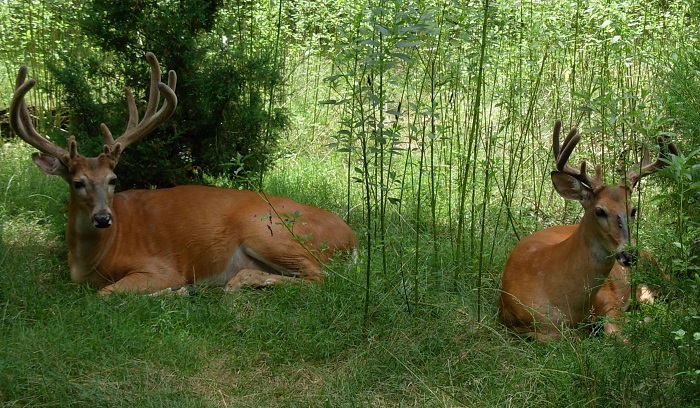
Researchers divide the deer family Cervidae into two major groups called the old-world deer and the new-world deer. Where the subfamily of the old world deer is called Cervinae, Capreolinae is the name of the subfamily of the new world deer.
This distinction and categories amongst the deer are made on the basis of the foot structure. Metapodia, the second and the fifth hand bones in the old world deer, have disappeared through evolution. However, they are still there in the new world deer!
The old-world deer belonging to the class Mammalia and order Artiodactyla has four genera, while the total number of species is fourteen. This animal has a short vomer, and only males grow antlers amongst them. Typically these deer prefer to stay in coniferous forests and can feed on invasive plants.
The new world deer belongs to the family Cervidae and the subfamily Capriolinae. These animals could be extremely small, and may also showcase massive physical characteristics and body mass. In total, it has twenty-seven species, and many species tend to reside in the woodlands of South America.
Amongst the new world deer, you would see the black-tailed deer residing in the pacific northwest in great abundance.
Taxonomy and Classification
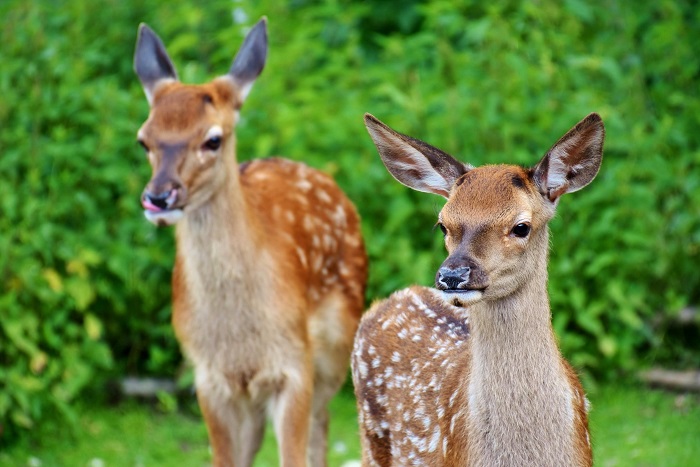
The order of Artiodactyla connects with the Carvidea family. It includes all the hoofed animals, meaning the even-toed creatures. In addition to deer, this family Cervidae also has giraffes, camels, and cattle as its main members. Millions of years ago, deer populations evolved into even-toed animals successfully.
According to taxonomists, deer can be categorized furthermore into three subfamilies. These include Capreolinae, Cervinae, and Hydropotinae. Where the Capreolinae encompasses reindeer and moose, the Cervinae includes red deer, tufted deer, and elk, and the Hydropotinae has a Chinese water deer as its member.
External Relationships
Deer acknowledges and reacts to other wildlife animals in quite an amusing manner. If the deer is a little alarmed or has a nervous feeling in front of the other animal, he would show his agitation by stomping the front foot on the ground.
One way of communication is by the deer waving the rail up and acting as if it’s a flag. In case of danger, the deer makes sure to have the tail up so the little one can follow it and the fawn’s life can be saved!
When interacting with other animals, sometimes the reactions are friendly, while other times they are not. Friendliest relations are obviously with animals of similar kinds like giraffes, camels, elk, zebra, horses, etc.
They try to avoid humans to the maximum. They shy away from interacting with them. Upon coming in contact with them, they either run away or try to cover themselves.
Internal Relationships
Deer is generally a friendly animal, and it prefers family groups when it comes to making relations. Females, however, showcase quite a unique pattern of sociability.
Female Deer Social Behaviour
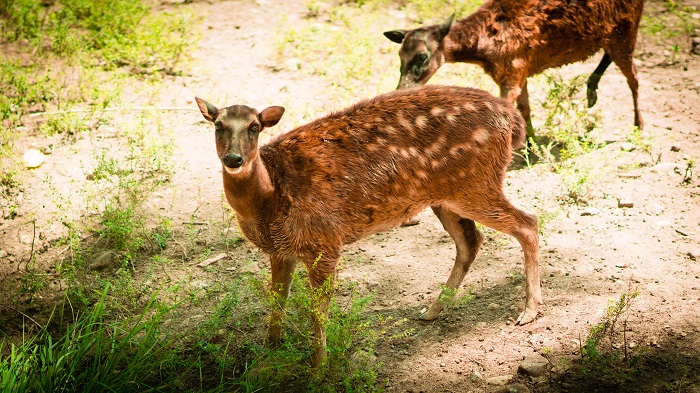
Being super social and amicable, the female deer mostly travel in herds. There is a matriarchal female deer that leads the entire group or herd. Also known as the alpha doe, she keeps an eye on possible danger and informs others about it through various actions.
The alpha doe is also a teacher and is good at intense fighting. She teaches the young ones how to survive a dangerous situation. You would be amazed to know that a herd member can find the alpha doe through her scent in case the group gets scattered on the arrival of predators.
Male deer also prefer being part of a herd. However, it’s only as long as they don’t develop mature antlers. Once they have the antlers and the mating season arrives, they tend to become territorial in order to avoid male competition.
The urge to showcase dominance over other members of the herd is also quite prevalent amongst deer. At times, there are fights over breeding, natural resources, and territory rights.
The body language of a deer that wants to exert its dominance over the herd showcases his intentions. Mostly, it’s his head position, which makes other members of the herd avoid interacting with him.
This animal is not very vocal. Rather, deer prefer to use body language over voice to communicate with each other. When a deer keeps a high-headed posture, it indicates that he is ready to fight or argue, while the lowered head and avoidance of eye connection showcase that the deer is in no mood to communicate.
Deer mostly prefer living in herds till the breeding season arrives. This social acknowledgment of each other in the form of grouping is for their own safety and avoidance of danger.
There is a hierarchy in the group as well. The deer with dominant personalities take this hierarchy quite seriously. As a matter of fact, when there are two dominant deer in a group, fighting for dominance is inevitable.
The deer antlers tend to help them the most in the fight. The two animals use their antler growth to have a head-to-head match with each other. The roe deer has larger antlers compared to others, which help it showcase its dominance over other. On the other hand, red deer with a normal antler size tend to live in a linear hierarchy.
How Long Does It Take for a Male Deer to Grow Antlers?
The young deer, also known as a fawn, don’t have antlers. However, the antler growth occurs as the deer grows. When it is around five months old, it grows the pedicles. Pedicles are not really antlers but are actually hairy bumps that are really small.
These pedicles are actually the base of antlers. Antlers are attached to them directly and to the skull as well. Male antlers really grow when the deer reaches the age of a year!
Once the antlers are grown, they keep shedding and regrowing. This is basically a yearly cycle of antlers for the bucks that repeats itself.
The Cycle of Growth

This cycle of growth and shedding is actually connected with the seasons. When it’s spring, the connectivity between the pedicle and the antlers gets weak. Hence, it leads to the shedding of the antlers.
These antlers are eaten by rodents, mainly squirrels. As they are abundant in protein, they are quite healthy for those who eat them.
Once the antlers are shed, there is immediate new antler growth in the deer. This growth continues throughout the summer season. This growth is around four inches each week. The velvet that had covered the blood vessels during the growth of the antlers sheds off as soon as the antler size is adequate.
With the breeding season starting during the months of fall, these matured antlers are used by the deer to fight off other deer.
The one with the largest antlers mostly wins in these breeding fights. Where all the species belonging to the deer family tend to protect the female harem, the white-tailed deer don’t do that!
As the winter season arrives, the antlers of deer start getting weak. So much so that late into the winter, the antlers are so weak that they end up falling off themselves. This is a yearly cycle that keeps repeating throughout the life of the bucks.
Here, there is a need to clarify that antlers and horns are not the same. Antlers tend to grow and fall off with the season. However, the horns don’t do that. Rather, they remain intact throughout the life of an animal and don’t shed off.
Are Deer Herbivores or Omnivores?

Deer are herbivores! They love eating greens and filling their bodies up with fiber. As a matter of fact, when it comes to devouring plants, they have their own choices and demands. A deer is a specialized herbivore. This means that it is highly selective when it comes to eating a type of plant.
While choosing the plants to feed on, the deer prefers those greens that are high in protein but are not loaded with too much fiber. This way, the food tends to be easily digestible and doesn’t get too heavy on the stomach. Mostly, it’s the aquatic plants, buds, fruits, herbs, and foliage that the deer feed on.
Deer is a ruminant animal. This means that they have rumens in them, which is an organ helping them digest even the toughest plants ever!
Some studies have showcased that at times, deer do feed on flesh as well. However, that’s highly occasional, which means it’s not too often. Some species of deer living in Africa have been seen devouring small frogs and insects. However, that’s also occasional.
Omnivores are animals that need both green as well as flesh for their survival. They feed on them both on a regular basis. Deer isn’t an omnivore as it feeds mostly on greens and relies on them only.
Herbivores are also categorized into two types: grazers and browsers. Browsers browse through the available food options and choose the high-quality food for themselves, which could be leaves or fruits of high trees. Comparatively, grazers devour grass only!
As deer species select and pick their own preferred greens, they are browsers. The deer browse through the available options and opt for low-fiber, high-protein plants.

Human Interaction- Do They Harm Humans?
The human interaction with deer is pretty interesting. As already mentioned, deer are shy animals and tend to avoid all kinds of interactions with other animals. When they come in contact with the humans, they either try to run away or hide somewhere.
Normally, being benign, deer are not harmful to humans. Rather, it’s the humans who go hunting for deer. However, during the rutting season, the deer tend to become a bit aggressive and may even end up attacking a hunting human as well.
Although, at other times, they are harmless to humans and don’t cause any problems to them as such!
This is why it is advised to humans to avoid deer during the mating season. As this season leads to some changes in the behavior of this animal, it’s better to stay away from it as much as possible.

Another circumstance in which you may see a deer attacking a human is when the latter goes hunting a fawn. Deer are, just like humans and other animals, super protective towards their kids.
Hence, any threat to them is not taken lightly, and a solid reaction is given. This is probably why most deer-hunting humans avoid attacking the young animals and rather go for the mature ones.
According to some statistics, a lot of deer have been responsible for the deaths of people in New York. Actually, that’s not the direct attack by the deer on the residents of New York. Rather, it’s simply the callous running of the deer and hitting a vehicle accident.
Deer vehicle collisions are quite common across the globe, especially in the United States of America. This, however, can’t be considered an ‘attack’ by the deer. Rather, it’s merely an accident!
Compared to other large mammals living on Earth, deer tend to avoid humans to the maximum. Theis most common reaction to the presence of a human is running away from them in order to save themselves from any possible hurt.
That’s another thing that many times, running away from them in populated areas leads to the deer colliding with a vehicle on the road and causing greater damage.
One problem that humans may have with the deer residing in a populated area could be the animal feeding on the well-organized and carefully designed gardens. A wandering deer may end up on a beautiful lawn, devouring the pretty fruits and buds! This may leave the owner fuming!
What Physical Feature Is Considered Characteristic of Deer?
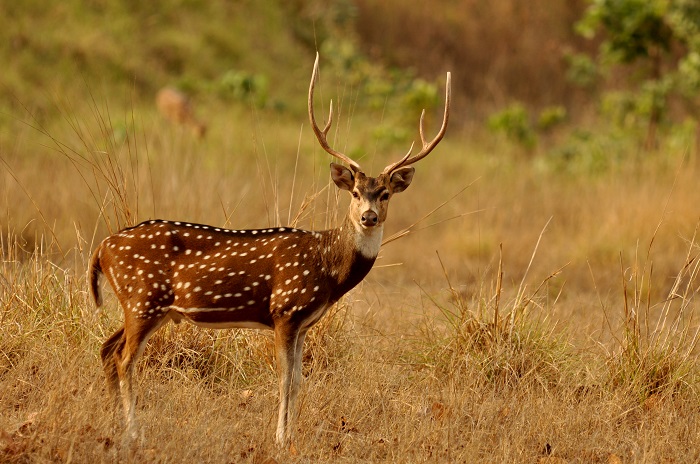
That one physical feature that is considered a characteristic of the deer is the antlers. Antlers are present in almost all species of deer, except one. Compared to all deer species in which only male possesses the antlers, only reindeer females have them.
These antlers showcase a growing and shedding cycle, which is annual. They have different appearances in different seasons.
These are the bone horns that develop in a fawn with time and become pretty strong before they are shed off and regrown. As soon as the mating season starts, they stop to grow and then shed off after this season ends.
To showcase their dominance over other deer in a herd, they show off their antlers. Mostly, it’s the deer with the largest antlers that gets to become the boss of the herd, as he would possess the ability to defend the group efficiently. Amongst all deer, the Alaskan moose has the largest antlers.
Ticks and Lyme Disease in Deer
Lyme disease is a condition in which the affected animal gets severe headaches, fever, and never-ending fatigue. Alongside this, there is also a skin rash known as erythema migrans. This disease is also referred to as a deer tick, as there is a particular tick that transmits the disease.
This tick feeds on the blood of the deer and then lays eggs. These eggs mature, and the disease spreads furthermore. A lot of people considered killing deer as a correct way of action in order to minimize the number of ticks.
As a matter of fact, people started killing deer in Crane Beach, and in 1991, the number of deer residing there was reduced to only a hundred! However, the disease still kept spreading at a regular pace.
Some recent studies have revealed that it’s not the deer that carries the bacteria causing Lyme disease. Killing the deer won’t stop the spread of the disease, as the remaining deer would anyway have enough surface area to carry the ticks and support them. You can’t simply kill all the animals to avoid the spread of diseases!
Some researchers from Northeastern University have come up with a chemical that kills the bacteria causing Lyme disease. However, it doesn’t affect animals. This is a breakthrough discovery that is surely beneficial for everyone.
Alongside this, once diagnosed, Lyme disease can easily be treated with the help of doxycycline. A single round of doxycycline is enough to end the infection and make the person healthy again within ten to fifteen days.
Hunting deer and killing it won’t help in eradicating Lyme disease for the reasons stated above. Rather, there is a need for better management of the disease than making the deer disappear from the face of the Earth.
Predators of Deer
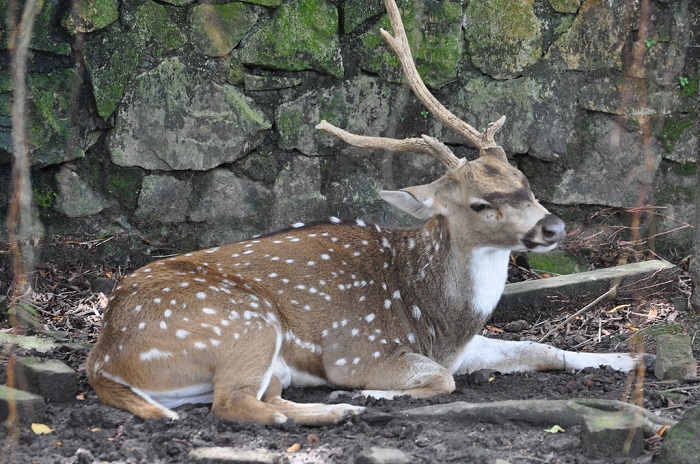
We, humans, can be considered the predators of deer! Hunting of deer is quite widespread across the globe. This is especially prevalent in Saskatchewan and hunters from all over the World head towards this hunting destination each year!
The biggest natural predator of the deer is the wolf. One of the biggest parts of the diet of wolves is the deer. As the wolves hunt in packs, it usually gets difficult for the deer to flee them. Also, being highly nutritional, even a single deer satisfies multiple wolves of the pack easily.
Just like wolves, coyotes are also the natural predators of deer and feed on them for their nutritional fulfillment. Being a scavenger, a coyote mostly eats up the deer that’s left back from the herd. Apart from them, bears also keep them in their diet along with various other small mammals.
The mule deer is eaten up by the mountain lions. Their menu also includes elks and moose. Next is the lynx, which loves feeding on the roe deer and the red deer. It’s also because most of the time, these two species of deer live close to where the lynx resides.
All the predators of deer that hunt them have extremely sharp teeth and really strong jaws.
Conclusion
Deer is a sweet and shy animal, introduced to most humans in their childhood through Bambi, a famous American animated film. Usually living in herds, they are sociable with species of their own types.
Being benign, they can coexist with humans, especially if they don’t damage their garden while feeding on perfectly curated plants and running over expensive pots.
Hope you enjoyed!


